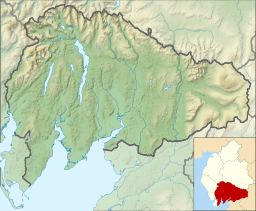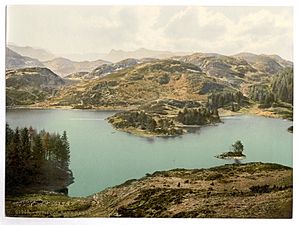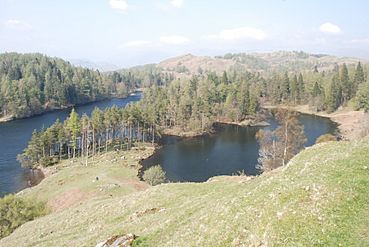Tarn Hows facts for kids
Quick facts for kids Tarn Hows |
|
|---|---|

Tarn Hows in winter 2006
|
|
| Location | Lake District |
| Coordinates | 54°23′N 3°02′W / 54.383°N 3.033°W |
| Type | artificial |
| Primary outflows | Tom Gill |
| Catchment area | 1.11 km2 (0.43 sq mi) |
| Basin countries | United Kingdom |
| Max. length | 0.971 km (0.603 mi) |
| Max. width | 0.258 km (0.160 mi) |
| Surface area | 15 ha (37 acres) |
| Average depth | 5.4 m (18 ft) |
| Max. depth | 8.8 m (29 ft) |
| Water volume | 0.000754 km3 (611 acre⋅ft) |
| Shore length1 | 3.1 km (1.9 mi) |
| Surface elevation | 180–188 m (591–617 ft) |
| Islands | 5 |
| 1 Shore length is not a well-defined measure. | |
Tarn Hows is a beautiful spot in the Lake District National Park in North West England. It has a lovely small lake, called a tarn. You can find it about 2 miles (3.2 km) northeast of Coniston and 1.5 miles (2.4 km) northwest of Hawkshead. Tarn Hows is super popular, attracting over half a million visitors each year in the 1970s. The National Trust looks after this special place today.
The tarn gets its water from streams and wet areas at its northern end. Water then flows out through a stream called Tom Gill. This stream tumbles down over small waterfalls to Glen Mary bridge. A famous writer, John Ruskin, thought Tom Gill needed a prettier name. So, he called the area 'Glen Mary'.
You might even recognize Tarn Hows from the racing game Forza Horizon 4.
Contents
Discovering Tarn Hows: A Look Back in Time
The area we call Tarn Hows today used to be quite different. It had three much smaller lakes: Low Tarn, Middle Tarn, and High Tarn.
In 1835, a guide by William Wordsworth suggested walkers visit this area. But it didn't even mention the small lakes!
Until 1862, much of Tarn Hows was open land where sheep could graze. The Marshall family owned most of the other land, including farms and quarries. James Garth Marshall, a Member of Parliament, took full control of the land in 1862. He then started making big changes.
He planted more spruce, larch, and pine trees around the lakes. He also built a dam at Low Tarn. This dam joined the three small lakes into the larger, single tarn we see today.
By 1899, Tarn Hows was already a famous beauty spot. People loved to skate there in winter and have picnics in summer. Visitors would arrive by horse-drawn buses from nearby towns. A wooden boathouse, which stood until the 1950s, was likely built around this time. In 1913, G.D. Abraham said Tarn Hows felt more like a Scottish loch than other Lakeland waters. He thought it was perfect for walking, not driving.
Beatrix Potter's Special Connection
In 1930, the Marshall family wanted to sell their huge 4,000-acre (16 km²) Monk Coniston estate. Beatrix Potter's husband, William Heelis, was the family's lawyer. So, Beatrix knew about the sale early on.
One of the farms on the estate had once belonged to her great-grandfather. Beatrix really wanted to buy the whole estate. She didn't want it to be sold off in small pieces for tourist buildings. However, she couldn't afford the full price herself. Neither the National Trust nor the Forestry Commission could raise the money fast enough either.
Beatrix and her husband worked out a deal to buy the whole estate for £15,000. They hoped the National Trust could then raise money from the public to buy back most of the land from her. During the time Beatrix and William owned the estate, they managed it very well.
The National Trust's fundraising worked! They raised almost enough money by the summer of 1930. They bought most of the land from Beatrix. She even secretly donated the last part herself. When the National Trust took over in September, they asked Beatrix to keep managing the land for them.
A National Trust agent later wrote that Tarn Hows was given to the nation by Sir Samuel Haslam Scott in 1930. He donated the money to help buy this part of the estate. The rest of the Monk Coniston estate was left to the National Trust in Beatrix Potter's will.
Tarn Hows Today: Managed by the National Trust
Tarn Hows was named a Site of Special Scientific Interest in 1965. This means it's a special place for nature and wildlife.
The National Trust has made changes over the years to protect the area. In the 1960s, they moved the car parks to a less noticeable spot. They also improved footpaths and roads to reduce damage from visitors. In 2008, a new building opened with toilets and information. It was designed to blend in with the landscape and has a special "green roof" covered in plants.
Understanding the Name: Etymology
The name "Tarn Hows" comes from old words. "Tarn" means 'the pool(s)' and "Hows" means 'the hills'. So, it means 'the hills by the pool(s)'.
There are five or six low hills around the area. The pools, which are now one big lake because of the dam, used to be separate. They were called 'The Tarns' (High, Middle, and Low Tarn). Both 'tjǫrn' and 'haugr' are words from Old Norse, an old language. 'Tarn' is a dialect word that came from 'tjǫrn'.
Gallery






